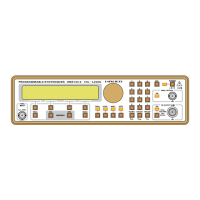11
Subject to change without notice
• DC coupled NUM (DC-100kHz).
• AC coupled NUM (10Hz-100kHz).
• Deviation (see corresponding paragraph).
example 1:
CH1→ modulation: first pulse width 150s.
second pulse width 1.1ms.
period 2.5ms (Fmod: 400Hz).
CH2 → moduled signal (deviation: 2kHz).
for carrier frequencies 16MHz, we get (for FM):
• DC coupled NUM (DC-30kHz).
• AC coupled NUM (10Hz-30kHz).
• AC coupled ANA (30kHz-100kHz)
• Deviation (see corresponding paragraph).
example 2:
In this example, external modulation signal is a «trinary» code
composed of 9 bits; 1 bit being composed itself of 2 narrow
or/and wide pulses, depending on the combinaison expected:
• A bit composed of 1 wide and
1 narrow pulses is a bit «OPEN».
• A bit composed of 2 narrow pulses
is a bit « LOW».
• A bit composed of 2 wide pulses
is a bit «HIGH».
For detecting the first bit , a synchronisation bit (long low level)
is present. The modulation frequency is here of 20Hz.
CH1 → modulation: narrow pulse of 200µs.
wide pulse of 1.8ms.
synchronisation bit of 14ms.
CH2 → zoom of CH1.
CH1 → demodulated signal: DC coupled, NUM position.
CH2 → demodulated signal: AC coupled, NUM position.
The return to the modulation menu is possible by pressing the
«PREV» key (3) and the return to the main display by pressing
the «ESC» key (13).
External modulation input is on the front panel «MOD.IN» (2).
The signal can be of any shape or amplitude, however the AM-
depth or FM/PM deviation programmed is calibrated only for
a 2 Vcc signal at the input.
Amplitude modulation (AM)
From the AM menu, after selecting of the context sensitive
keys «D%» (5), we get:
A new value of this depth can be entered from the data keypad
(11) or modified by the digital rotary (10) or one of the four
context sensitive keys (5).
The depth range may be change from: 0 to 100% with a
resolution of 0.1%.
The return to the previous menu is possible by pressing the
«PREV» key (3) and the return to the main display by pressing
the «ESC» key (13).
example 3:
For AM sine (depth : 50%), we get:
Operation - Amplitude Modulation

